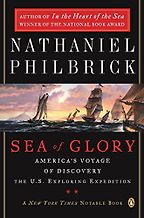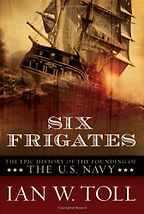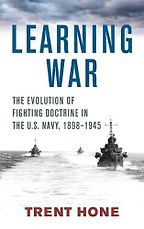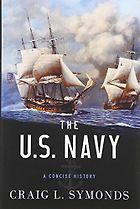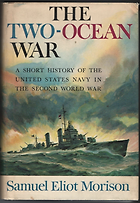As the first Chief Learning Officer for the United States Navy, you directed the education of America’s sea service. So I thought you would be the ideal person to ask for five books about American naval history. What criteria guided your choices?
These books are my go-to list for general readers, people who don’t work in the national security world. I steered clear of books that are read mostly by Navy and Marine Corps officers and focused on books I thought a well-educated general reader should read and would like to read.
That’s our audience, so thank you. Let’s begin with a promising title, for our purposes, The US Navy: A Concise History by a professor emeritus from the United States Naval Academy.
The great English naval historian, Nicholas Roger, who you interviewed about naval history, said, “There’s no shortage of books about the US Navy, most of which are perfectly dreadful.” I agree. But The US Navy is a gem. The book is very short, only a hundred pages long. Craig Symonds is undoubtedly the best of the current generation of American naval historians. If a civilian asked me for one book they should read to understand the US Navy, I’d tell them to get this.
Seems like Symonds isn’t just summarizing, he’s also arguing that the Navy reflects the history of the United States as a whole. Can you make his case?
The Navy is deeply woven into the fabric of the US, although we don’t pay much attention to it. For example, people read a lot of books about the causes of the Civil War and its land battles, but little about the naval aspects of the war, which were essential to the outcome. The US Navy’s successful effort to choke off commerce during the Civil War drove the defeat of the South.
“The Navy is deeply woven into the fabric of the United States”
This book also highlights the lack of consistent political support for the Navy. Unlike other branches of the United States Armed Forces, the US Navy is constantly in a boom-bust cycle. Political support for the Navy ebbs until the sea force is called upon to defend the United States, and then there is a major expansion. To give you a sense of the scope of the boom-bust cycle, at the end of World War II, we had an astounding 65,000 ships on the US Navy register; today we have about 295. This history of political oscillation, where the Navy falls into disrepair and neglect and then goes through major expansion, continues today. Symonds gives you a great sense of that history.
Carrying on to your next recommendation. Tell me about Six Frigates by freelance military historian Ian Tolls.
Ian Tolls is a wonderful writer. Six Frigates is the story of the Navy before and during the war of 1812. One might think: Why read about a war which had little impact on the course of American history? Six Frigates is fascinating, though, and it’s an important read because the US Navy’s DNA comes out of this conflict.
Six Frigates highlights an interesting fact: that the US Navy’s ship design was extraordinarily innovative from its inception. The title, Six Frigates, is a reference to the Naval Act of 1794. After the American Revolution, as part of that boom-bust process we talked about, the Navy was eliminated. It had to be restarted by the Naval Act of 1794. The bill called for construction of six frigates, which are intermediate-sized ships. These new American ships were far superior, technologically, than virtually anything built by other navies at the time. They were faster than any ship that could outgun them. If they encountered an opponent with with bigger guns, they could simply run away. And if any ship was fast enough to catch one of them, the US frigates could outgun it. The white oak used in construction was incredibly hard and durable. The result was a class of magnificent fighting ships. The USS Constitution, which is still moored in Boston Harbor, is the most famous of the six frigates.
Get the weekly Five Books newsletter
The values that still shape the Navy also come from the War of 1812, in which the US Navy was clearly the underdog. The famous saying of James Lawrence, the Captain of the Chesapeake—“Don’t give up the ship!”—remains the governing mantra of the US Navy. It represents a commitment to never quit, to be willing to make great sacrifices to achieve victory. That principle is beaten into students’ heads at the US Naval Academy. So, Six Frigates is a wonderful read that will help you understand the values of the Navy.
In my ignorance, wasn’t ‘Don’t give up the ship’ the standard policy for a ship’s captain? Is this governing mantra unique to the US Navy? What else makes the US Navy unique?
This quote became famous because it was considered normal in many navies to strike your colors and surrender to greater force. Fighting to the finish when you were overmatched was not common in Enlightenment Era naval wars. Surrender was much more common. So yes, this is something special about American naval culture.
The other thing that is unique about US Naval culture is, again, that the Navy has been ignored for long periods in our history. You can see this today, despite the Navy’s importance to our defense. If you ask the average American even the most basic questions about the navy, they would have a hard time giving you an answer. The size of the US Navy hasn’t been a political issue in a presidential campaign since the Reagan Administration, even though the US is a major maritime nation. So our Navy often has the unenviable task of preparing for war without enough resources. That creates a culture that emphasizes adaptation and rapid innovation in the face of long odds.
Speaking of Americans’ ignorance: You were a Marine. I’ve never been clear about the relationship between the US Marines and the US Navy. Please enlighten me.
The United States military has four major branches—Army, Air Force, Navy, and Marines—but there are only three military departments: Army, Air Force and Navy. The Marines are an integral part of Navy Department. This has many ramifications. For example the Marines don’t have their own military academy. Budding Marine Corps officers go to the Naval Academy and Navy Reserve Officers Training Corps.
The relationship between the Marines and the Navy is a byproduct of two historical developments. One is that the Marines began as sea soldiers—sharpshooters who would man the crow’s nests high up in the rigging of our sailing ships and shoot down at the crew of opposing ships. And during World War II, the naval identity of the Marines was reinforced by the fact that the Marines pioneered and specialized in amphibious assault. The Marine Corps remains very much part of the Naval service today.
So why is the Marine Corps still set apart from the Navy and how independent is it?
The Corps developed as a separate service in part because Marines did not need to be sailors. They did not need to know how to handle sailing craft. They only needed to understand their piece of naval warfare, which was combat. So, it’s a separate service, with its own budget, but it’s very deeply integrated into the Navy. As a Marine, I had two long deployments on Navy ships, and that’s very common in a Marine Corps career. Today, the Marines engage in joint planning with the Navy to prepare for potential maritime conflicts in the Baltic Sea, Black Sea, and the Pacific.
My six-year-old is pirate-ophile, so the debased reputation of seamen is at the forefront of my mind. How does the reputation of old salts flavor the institution of the Navy?
What an interesting question! Historically, sailors were sailors, interchangeable. For a big chunk of the 19th century, a commercial sailor and a member of the Navy had similar sets of skills and some sailors might move back and forth between the private sector and public service. That changed when we moved from the age of sail to the era beginning with the Civil War when naval technology became much more advanced. You start getting armaments and propulsion systems that are unlike anything used in commercial craft, and that made the Navy a thing apart. Today, for example, a naval officer used to commanding subs and ships powered by nuclear propulsion are not likely to seek work commanding a non-nuclear civilian ship. There is no longer much intersection between those two worlds.
I love Nathaniel Philbrick’s prize-winning Sea of Glory: America’s Voyage of Discovery. What is this treasure of a book about and why have you recommended it?
This is the story of a group of American sailors who explored the Pacific in the years before the US Civil War. Before Philbrick’s book, this part of our naval history had largely been forgotten. I chose this book because we tend to think of the US Navy as a fighting force, but the Navy has made major contributions to science, particularly in the 19th century. For example, the person who is often cited as the founder of modern oceanography, Matthew Maury, was a US Naval Officer as well as a scientist. Sea of Glory reminds us of this chapter of the Navy’s history, which has long been overlooked.
The subject of Philbrick’s book, the United States Exploring Expedition, commanded by Navy officer Charles Wilkes, made major contributions to American science, spending years charting the West Coast and 800 islands in the Pacific. They also explored Antarctica, a giant piece of which is still called Wilkes Land. The collections of plant and animal specimens the Wilkes Expedition brought back were the foundation of the collections of the Smithsonian Museum and the National Botanical Garden. It’s a fascinating story that reminds us that the Navy has done more than fight during its history.
How is the history of the US Navy shaped by the fact that the United States is a bicoastal landmass bordering the world’s two biggest oceans?
Much of our involvement with Latin America has been driven by the fact that we possess two coasts but only one navy. We desperately wanted a fast way to shift fleets from the Atlantic to the Pacific without going the long way, around Cape Horn. So we intervened in Central America, helped create the nation of Panama, and built the canal, which still provides the only way to move US Naval forces quickly from the East Coast to the West Coast. Our subsequent history of intervention in Latin America was driven by our desire to protect the canal. You can’t really understand the United States and our fraught and complex relationships with Central America, Cuba or Puerto Rico without understanding US Naval history.
Samuel Eliot Morison was among the most august historians who took the sea as his main subject. He was awarded two Pulitzers and two Bancroft Prizes. You’ve recommended his The Two-Ocean War.
Samuel Eliot Morison was a fascinating throwback figure, a Boston Brahmin who used to ride his horse from Back Bay to Harvard Yard. Before the Second World War, he was known primarily as a historian of early America. On the eve of the war, however, he published a biography of Christopher Columbus. During research for the book, he spent four months at sea, sailing the route of Columbia’s four voyages, and this gave him a reputation as a historian-sailor. As soon as the US entered World War II, he wrote to President Franklin Roosevelt, a fellow Harvard alum, asking to be commissioned as the official historian of the US Navy and to be allowed to serve on vessels in combat zones.
Five Books interviews are expensive to produce. If you're enjoying this interview, please support us by donating a small amount.
Morrison saw service on eleven different ships over the course of World War II and saw battle repeatedly. After the war, he published a magnificent 15-volume history of the Navy’s war. This book is the short one volume version. It’s the American Iliad. If you want to understand what World War II felt like for a participant, with the perspective of a great historian, this would be the book.
Morrison is not trying to be neutral. Some might consider that a weakness. I consider it a strength. Sophisticated readers can see through his nationalism. No other historian gives us a feel for what this conflict meant to Americans serving on naval vessels during World War II. A great quote from the book captures this. “To witness the conduct of the average enlisted man … would make any man proud to be an average American.” This is really what the book is about, how a group of civilian-sailors went to war to protect democracy, written by someone who deeply respected both the purpose of the war and the people who served in the Navy.
Has the importance of the United States Navy to US national security ebbed since the end of World War II? Or is it just more submerged in the national consciousness?
Submerged would be the right word! A huge part of the story of the Cold War is the history of the US Submarine Force, which had the responsibility of carrying ICBMs [intercontinental ballistic missiles] and hunting Soviet missile subs that were hard to find. The US Navy was a key part of deterrence. Submarines protected us from nuclear strike. Though the Navy was somewhat unsung during the Cold War, it played a crucial role.
Since the end of the Cold War, the Navy has declined even further in American consciousness. After the fall of the Berlin Wall, the conflicts the United States has been involved in, like Iraq and Afghanistan, have been largely land-based. The Navy has played a supporting role, particularly the Navy Seals in special operations, but there has not been naval combat at sea. So, we’ve tended not to focus on the Navy. Funding has not been robust. The Navy currently has 297 vessels, which is tiny based on its 20th-century averages, and roughly half the size of the Navy at the end of the Cold War.
We might be coming out of that boom-bust cycle I talked about earlier. There’s probably going to be renewed focus on the Navy over the next 20 years as part of the so-called ‘pivot to Asia’ and the need to deter conflict in the Pacific Theater.
Your final recommendation is Learning War: The Evolution of Fighting Doctrine in the U.S. Navy, a publication of the Naval Institute Press, by Trent Hone. What will we learn about American naval history by reading it?
This is the one history book on my list most likely to be read and discussed by Navy officers today. Trent Hone is a second generation naval historian. His father was a well-known naval historian as well. Hone starts with an important question: Why was the US Navy so successful in World War II? And he comes up with two important answers.
According to Hone, what made the US Navy successful was a culture of learning. Naval officers during the 1920s and 1930s didn’t learn strict doctrine, but “clouds of options.” They came to naval problems not with a set of steps to follow, but with a big menu of options to consider. This gave them a flexibility that allowed successful adaptation and response to unexpected developments, like the sinking of most of our battleships at Pearl Harbor. Hone also emphasizes decentralization. The Navy in World War II decentralized decision-making. Subordinates had a lot of authority to carry out the objectives set by their superiors, within set parameters.
In the Navy today, there’s a fear that we’ve moved too far away from the intellectual roots Trent identifies. I was brought into the Pentagon as Chief Learning Officer to reinvigorate the Navy’s intellectual foundations. To give you a sense of the problem: in World War II, 99% of admirals went to the Naval War College before the war. Today, that number is more like 20%. Hone’s book is a reminder that the Navy’s success rests on intellectual understanding and development—a fact which we neglect at our own peril.
When you left your job with the US Navy, you wrote: “The primary naval responsibility of every administration is to define the navy the United States will need in coming decades to protect national security.” What, in your view, are the most important factors that must be taken into consideration when defining the Navy for the rest of the century?
The most important thing? That if we ignore the link between our naval strength and our space and cyber capabilities, we will regret it. The Navy thinks primarily about ships on top of the water and subs below the surface. Officers graduating from the Naval Academy gravitate towards submarines and surface warfare. That’s no longer sufficient.
Get the weekly Five Books newsletter
After the advent of naval aviation, in the 1930s, our naval technology was nearly useless without air cover. It’s the same with these new tech capabilities. All our ships and all our weapons navigate by GPS, which relies on satellites. If our satellites are knocked-out, our advanced weaponry will become useless. As space is militarized this threat gets greater. Similarly, our command and control systems rely on our communications capabilities, which depend on cyber and software. Space and cyber are critical to our strength and defining the Navy the US will need in the coming decades.
Five Books aims to keep its book recommendations and interviews up to date. If you are the interviewee and would like to update your choice of books (or even just what you say about them) please email us at [email protected]
